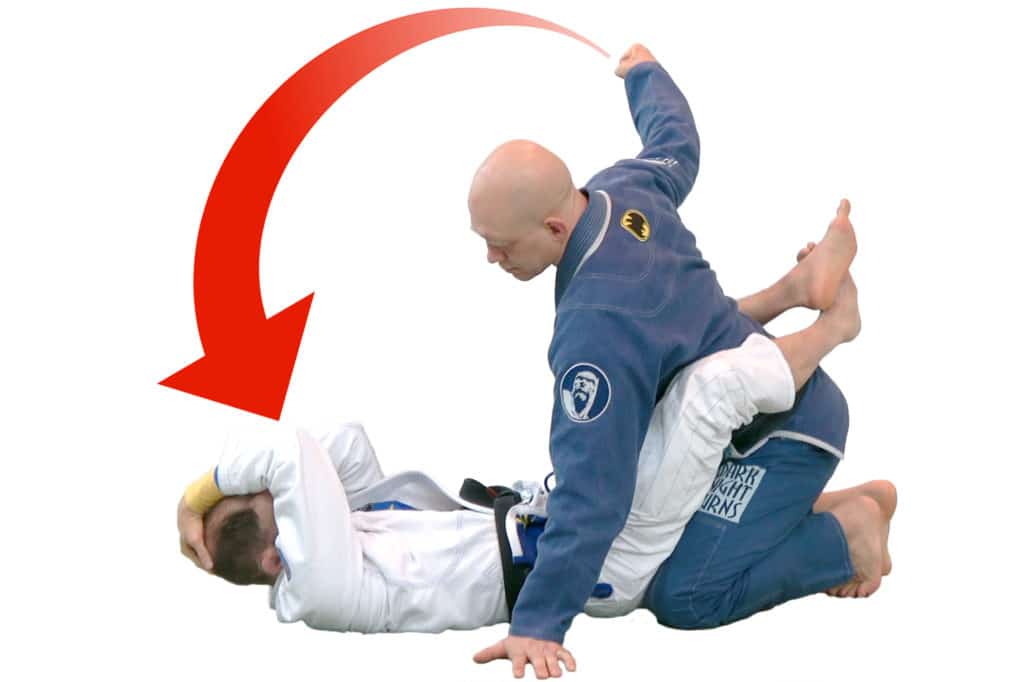How to Stay Safe on the Ground When a Larger Opponent Is Trying to Punch Your Teeth Down Your Throat

The Brand New ‘Self Defense Guard’ by Elliott Bayev and Stephan Kesting
New Release Sale, $70 Off!
This new, step-by-step instructional, teaches you how to defend yourself and win when you’re on the bottom. Four hours of instruction in two volumes, with an unconditional 365 day moneyback guarantee.


These days every wannabe tough guy watches the UFC. And that means that bad guys all know the power of tackling someone to the ground and then pounding that person into oblivion.
But it doesn’t even need to be that deliberate, because you can also end up under your attacker just by chance.
A clinch gone bad, a surprise bum rush, even a slip and fall… One second you’re up on your feet and then suddenly – BOOM – you’re flat on your back with punches raining down.
Of course it’s true that in a self defense situation you may not necessarily want to go to the ground. Staying off the ground allows you to punch, kick, elbow, knee, and – most importantly – run away. So definitely keep the fight on the feet if that’s where you feel comfortable.
But it’s really important to realise that you may not have a choice about staying on your feet. The ground happens and when it does, you need answers.
So even if your entire game is based around staying on your feet better have a plan if you end up on the ground. You absolutely need to know what to do when you’re on the ground with an attacker above you.
And that means having the techniques and the strategies to survive on the bottom.
Hope for the best but prepare for the worst!
The Guard Is the Key to Survival on the Ground
You’ve probably heard about Brazilian Jiu-Jitsu and seen it in the UFC. This martial art is one of the most efficient and effective ways to control and defeat an opponent with grappling.
Now you don’t have to learn every aspect of Brazilian jiu-jitsu in order to survive on the ground.
After all, if you’re on top then you can simply stand up and disengage.
But what if you’re on the bottom?
The guard from Brazilian Jiu-Jitsu is a position, along with a set of techniques, tools and tactics, that you use when you’re on your back and your opponent is above you.
It’s called “the guard” because it uses your legs to protect your head (unlike other positions on the ground where you are much more vulnerable).
The guard allows you to control the range between you and your opponent.
This isn’t as simple as just wildly kicking your opponent away with your legs. If you do that continuously you’re simultaneously going to get exhausted and give a semi-skilled opponent a TON of opportunities to pass your guard and putting you into real trouble!
Once you add controlling the grips to controlling the distance you then make it MUCH harder for your opponent to hurt you. He’ll find himself with his arms entangled and posture broken, unable to generate the power he needs to land a strong shot.
Not getting hurt is the most important thing of course, but what comes next?
If you know what to do then you can use the guard to get back to your feet, even if he’s driving all of his weight down into you…
Or you can break his arms, especially if he tries to punch or choke you…
Or you can choke him out and render him helpless…
Or you can sweep him so you end up on in a dominant position on top.
The guard is all about having options to choose from and to respond to your opponent with.
But Even Longtime BJJ Students May Not Use the Guard Correctly in a Real Fight
The core of BJJ is self defense.
That means knowing what to do when you’re flat on the ground with an attacker above you raining down punches
Now in sport jiu-jitsu the guard has evolved quite a bit away from its combative origins. In BJJ competitions it’s not unusual to see players flip upside down, lie with their legs dangling in the air, and fight for positions that might get their faces smashed in a real fight.
It’s not that the guard of sport jiu-jitsu is bad; it’s simply that it needs to be recalibrated so that you don’t make critical errors when using it in a real fight.
Self Defense Guard Techniques and Strategies
This instructional program is our brand new, step-by-step progression for learning to use the guard in a self defense situation.
First you’ll learn how to use the guard correctly in a self defense context to make it almost impossible for your opponent to land that big fight-ending KO punch.
Then you’ll learn how to manipulate his body to off-balance him
tktktktktk
With BJJ black belt instructors Elliott Bayev and Stephan Kesting
tktktkttktktktk
What’s In The Self Defense Guard?
There are two volumes and over 4 hours of instruction in The Self Defense Guard…
Volume 1, the Basic Self Defense Guard
1. Introduction – Self Defense Philosophy and Training
2. Shin Shield Distance Control to Standing in Base
3. Guillotine Choke vs Grab While Standing Up in Base
4. BJJ Penn Guard Hip Bump
5. BJJ Penn Guillotine
6. Options From Closed Guard vs Punches and Strikes
7. Clinching vs Strikes in Closed Guard
8. Controlling Opponent’s Posture
9. Escape, Choke or Sweep vs Forearm in Throat
10 Haymaker to Elevator Sweep
11. Double Armbar vs Bully Choke
12. ‘Black Belt Hips’ Armbar vs Bully Choke
13. Sweeping vs the Driving Headlock in Your Closed Guard
14. Headlock Escape 1, Hooking the Head
15. Headlock Escape 2, Hooking the Top Leg
16. Headlock Escape 3, Turn to Knees
17. Taking the Back From Closed Guard
18. Upgrading to the Damned Good Guard
19. The Self Defense Triangle
20. Standing in Base From the Overhook
21. Standing Up From the Overhook to Guillotine
22. Defending Punches vs Unbroken Posture And Defending vs Groin Strikes
Volume 2, Advanced Self Defense Guard
23. Open Guard Maintenance and Distance Management vs Standing Opponents
24. De la Riva for Self Defense and the Trap Door Back Take
25. Standing Tripod Hook Sweep
26. Hooking Knees and the Tomahawk Sweep
27. No Gi Spider Guard Control
28. Striking from the No Gi Spider Guard
29. Triangle Choke from No Gi Spider Guard
30. Kimura from No Gi Spider Guard
31. The Winter Guard and the Cross Choke
32. Omoplata from Winter Guard
33. The Collar Sleeve Spider Guard for Self Defense
34. Getting to the Collar Sleeve Spider Guard
35. Triangle Choke From the Collar Sleeve Spider Guard
36. Armbar From the Collar Sleeve Spider Guard
37. Balloon Sweep from the Collar Sleeve Spider Guard
38. Slithering Armbar from the Collar Sleeve Spider Guard
39. Entering and Controlling the K Guard
40. Triangle Choke from the K Guard
41. Armbar From the K Guard
42. Rollover Sweep, Kneebar and Heel Hooks from K Guard
43. Areas for Future Exploration
Our Unconditional 365 Day Money Back Guarantee
If you buy this instructional then I want you to be happy with your purchase. It’s really as simple as that.
If you don’t like the materials for any reason, or if you decide that they just aren’t right for you anytime in the first 365 days, then simply return them for a full refund.
No hoops. No hassle. No risk.
The bottom line is that if after you go through all the materials you don’t think that it took months off of your BJJ learning curve then I don’t deserve your money.
And it’s a no-questions-asked policy; just return the materials to me and I’ll happily refund your payment. This takes all the risk off of you and puts it back onto me, which is exactly how it should be!
Instant Digital Access or Physical DVDs, It’s Your Choice…
You can now get all the techniques in The Self Defense Guard in two different ways…
- Instant access online streaming to your computer, phone or tablet, or
- Two physical DVDs with more than four hours of instruction total and free shipping anywhere in the world






